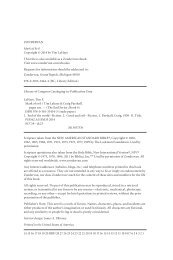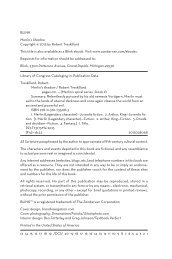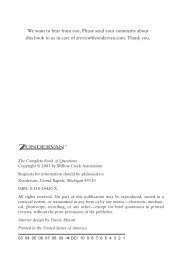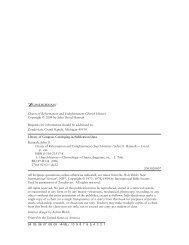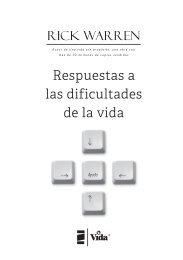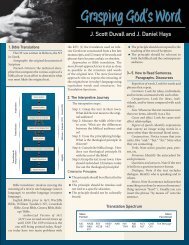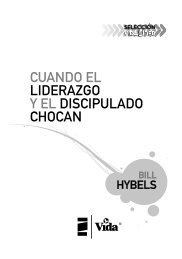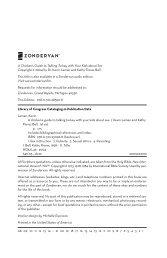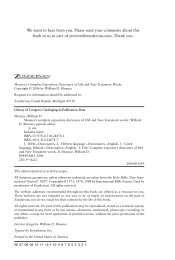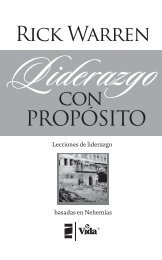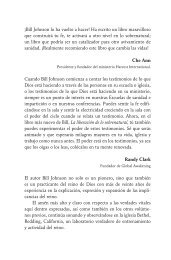Published for distribution in Africa by WordAlive Publishers, PO Box ...
Published for distribution in Africa by WordAlive Publishers, PO Box ...
Published for distribution in Africa by WordAlive Publishers, PO Box ...
You also want an ePaper? Increase the reach of your titles
YUMPU automatically turns print PDFs into web optimized ePapers that Google loves.
Genesis 1:3–3111they could be assigned to their place. He was controll<strong>in</strong>gthe creation project, with the result that all creation takesplace under God’s watchful eye and results from his power.This account of the creation <strong>in</strong> six days (whether takenliterally as twenty-four hour days or figuratively as represent<strong>in</strong>glong periods of time) reveals a methodical God whocreated different th<strong>in</strong>gs one after another with precise purpose.One <strong>by</strong> one the Lord puts <strong>in</strong> place all the elementsnecessary to susta<strong>in</strong> the human be<strong>in</strong>gs <strong>for</strong> whom he is creat<strong>in</strong>gthis world.As we read this account, we should note that each newstage <strong>in</strong> God’s work beg<strong>in</strong>s with his some <strong>for</strong>m of his creativewords, let there be (1:3, 6, 9, 14, 20, 24, 26). At the endof each of his creative utterances, there is some <strong>for</strong>m of thestatement, and it was so (1:7, 9, 11, 15, 24, 30). No matterwhat God ordered to come <strong>in</strong>to be<strong>in</strong>g, gather or separate,it came to be. He has the power to create and the powerto order his creation. We can rely on this same power <strong>in</strong>our circumstances. The God of creation is still the God ofhistory. If we listen to his word and submit our plans to hiswill, he can speak to raise <strong>Africa</strong> to great heights!The first th<strong>in</strong>g that God created out of the raw materialof the universe was light (1:3-5). It was created be<strong>for</strong>e everyth<strong>in</strong>gelse because it would be essential <strong>for</strong> the survivalof future plants, animals and human be<strong>in</strong>gs. Though theheavenly bodies were not yet created, the light permittedthe Creator to give <strong>in</strong>itial temporal structure to his creation:day and night, even<strong>in</strong>g and morn<strong>in</strong>g.Dur<strong>in</strong>g the second phase of his creation, cover<strong>in</strong>g daystwo to four, God provided the material framework to susta<strong>in</strong>liv<strong>in</strong>g be<strong>in</strong>gs. He created the sky (1:6-8), followed <strong>by</strong> seaand dry land (1:9). The dry land would be the ma<strong>in</strong> arena<strong>for</strong> human life and would provide the <strong>in</strong>gredients <strong>for</strong> thatlife (see 2:7). It was only after he had <strong>for</strong>med the dry groundthat God pronounced his creation good (1:10).This earth was then blessed with plants that will providefood <strong>for</strong> human be<strong>in</strong>gs once they are created (1:11-13; 29-30). F<strong>in</strong>ally, the stars and their movements were speciallyprovided to help the future occupants of the earth to organizetime <strong>by</strong> mark<strong>in</strong>g seasons and days and years (1:14-19).The way the Creator brought together all that was necessary<strong>for</strong> our survival be<strong>for</strong>e creat<strong>in</strong>g us rem<strong>in</strong>ds us that Godwas work<strong>in</strong>g <strong>for</strong> our good, not creat<strong>in</strong>g us so that we mightsuffer (Lam 3:33; Ezek 33:11).The creation of liv<strong>in</strong>g be<strong>in</strong>gs follows the same sequenceas the material creation. On day five, God created the creaturesthat live <strong>in</strong> sea and sky (1:20-23), followed on thesixth day <strong>by</strong> animals that live on land (1:24-25), and f<strong>in</strong>allythe culm<strong>in</strong>ation of his creation, human be<strong>in</strong>gs.The privileged position of human be<strong>in</strong>gs is shown <strong>by</strong> thefact that our creation required a special decision, presentedas if it was made at some great gather<strong>in</strong>g. The plural <strong>in</strong> letus make man <strong>in</strong>dicates the solemnity of the decision andstresses that someth<strong>in</strong>g new and important is about tohappen (1:26a). The plural ‘let us’ also suggests the communityof the Godhead, which <strong>in</strong>volves three persons – theFather, Son and Holy Spirit.Human be<strong>in</strong>gs, both male and female, are said to havebeen made <strong>in</strong> the image of God (1:26b-27). Thus humansare different from other created be<strong>in</strong>gs like animals, andthis fact has important consequences <strong>for</strong> how we live. Firstof all, it means that every human be<strong>in</strong>g resembles his or herCreator <strong>in</strong> some way. Consequently, every human be<strong>in</strong>g isspecial and important. We should be able to recognize theCreator <strong>in</strong> the men and women we see around us. Second, itmeans that we should not worship any animal (Exod 20:4;Rom 1:21-22). Woe to the person who lowers himself tothe level of animals <strong>by</strong> giv<strong>in</strong>g an animal or an image of ananimal the place that belongs only to the Creator! Third,because God created both our bodies and our spirits, wemust not artificially separate the two and th<strong>in</strong>k that we canignore our bodies while liv<strong>in</strong>g to God <strong>in</strong> our spirits. Scripturemakes it pla<strong>in</strong> that we must not mistreat our own bodies orthose of others (1 Cor 6:19-20).Both men and women were blessed <strong>by</strong> God and assigneda two-fold mission: to <strong>in</strong>crease <strong>in</strong> number and fill the earth(1:28a) and to rule over creation and to subdue the earth(1:26c, 28b). This mission was not a heavy burden but agift from God. Human be<strong>in</strong>gs were to occupy and enjoy, notfear, creation. This mission <strong>in</strong>dicates that the first way <strong>in</strong>which all of us can glorify and serve God is <strong>by</strong> car<strong>in</strong>g <strong>for</strong>his creation.It is important to note that men and women were permittedto rule only over other liv<strong>in</strong>g creatures, not over otherhuman be<strong>in</strong>gs. Nor were men given authority to dom<strong>in</strong>atewomen (or vice versa). Our fellow human be<strong>in</strong>gs bear theimage of the Creator and thus are not to be dom<strong>in</strong>ated butto be served (John 13:13-14; Gal 5:13; Eph 5:21). For foodGod supplied every seed-bear<strong>in</strong>g plant on the face of the wholeearth and every tree that has fruit with seed <strong>in</strong> it (1:29-30). Itthus appears that humans and animals were orig<strong>in</strong>ally vegetarian.It is only <strong>in</strong> 9:3 that we are permitted to eat othercreatures <strong>for</strong> food.The chapter ends with another summary of all God’s actsof creation: God saw all that he had made, and it was verygood (1:31; see 1:4, 10, 18, 21, 25). Noth<strong>in</strong>g comes fromthe hand of God that is not <strong>in</strong>tr<strong>in</strong>sically good. He is the goodGod who does all th<strong>in</strong>gs <strong>for</strong> good (Mark 10:18; Rom 8:28).God may have viewed his creation as good because itbreathed order. Each element was created at the appropriatetime and occupied the place which allowed <strong>for</strong> the harmony ofthe whole. It was also filled with rich diversity. God createddifferent species with<strong>in</strong> each vegetable and animal family,each accord<strong>in</strong>g to their k<strong>in</strong>ds (1:11, 12, 21, 24). Each k<strong>in</strong>d wastold to multiply (1:11, 20, 22, 28). F<strong>in</strong>ally, his creation was



